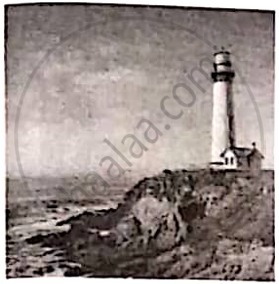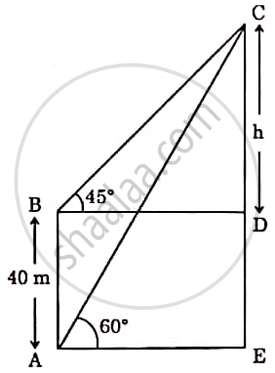Advertisements
Advertisements
Question
Amrita stood near the base of a lighthouse, gazing up at its towering height. She measured the angle of elevation to the top and found it to be 60°. Then she climbed a nearby observation deck. 40 metres higher than her original position and noticed the angle of elevation to the top of lighthouse to be 45°.


Based on the above given information, answer the following questions:
(i) If CD is h metres, find the distance BD in terms of 'h'.
(ii) Find distance BC in terms of 'h'.
(iii) (a) Find the height CE of the lighthouse [Use `sqrt3` = 1.73]
OR
(iii) (b) Find distance AE, if AC = 100m.
Solution
(i) From the right-angled triangle BDC:
`tan 45^@ = h/"BD"`
Since tan 45° = 1, we get
`1 = h/"BD"`
BD = h
(ii) From the right-angled triangle ABC:
`tan 60^@ = (BC)/(AE)`
Since tan 60° = `sqrt3`, we get:
`sqrt3 = (BC)/(AE)`
`BC = sqrt3 xx AE`
BC = BD + 40
BC = h + 40
h + 40 = `sqrt3 xx AE`
(iii) (a) Since CE + BC + h, substituting BC = h + 40:
CE = (h + 40) + h
CE = 2h + 40
To find h, we use:
h + 40 = 1.73 × AE
h = 1.73AE − 40
From (i) BD = h, using triangle BDC:
h = AE
CE = 2(AE) + 40
If AE = 100 (from part (iii) (b)):
CE = 2(100) + 40
CE = 240 meters
OR
(iii) (b) From the right triangle ACD:
`tan 60^@ = (CD)/(AE)`
`sqrt3 = (h + 40)/(AE)`
`AE = (h + 40)/(sqrt3)`
If AC = 100, using Pythagoras Theorem in ACD:
AC2 = AE2 + CD2
Substituting values,
1002 = AE2 + (h + 40)2
`10000 = ((h + 40)/(sqrt3))^2 + (h + 40)^2`
`10000 = ((h + 40)^2)/(3) + (h + 40)^2`
`10000 = (4(h + 40)^2)/(3) + (3(h + 40)^2)/(3)`
`10000 = (4(h + 40)^2)/(3)`
Multiplying both sides by `3/4`
`3/4 xx 10000 = (h + 40)^2`
7500 = (h + 40)2
Taking the square root on both sides:
`h + 40 = sqrt7500`
h + 40 = 86.6
h = 46.6
AE = `(h + 40)/(sqrt3)`
AE = `(86.6)/(1.73)`
AE = 50
